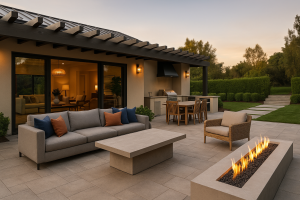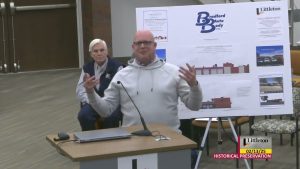If you’re a homeowner, it’s essential to have some knowledge about the different components that make up your roof system. Roof fascia is one such important component that plays a crucial role in maintaining the integrity of your roof. In this article, we’ll take a close look at what roof fascia is and why it’s vital to understand it for home maintenance.
Roof fascia is a horizontal band that runs along the lower edge of the roofline and holds the gutters in place. It’s typically made of wood, metal, or vinyl and serves several important functions. By providing a smooth edge to the roof, it helps protect against water damage and adds to the aesthetic appeal of your home.
What Does Roof Fascia Do?
Roof fascia is an essential component of any roof construction, playing a crucial role in protecting the roof and interior of a house from water damage. It is essentially a horizontal board that is attached to the end of the roof rafters, providing a smooth and continuous appearance to the edge of the roof.
The primary function of roof fascia is to protect the roof from water damage. Without it, water can seep into the roof structure, causing rot, decay, and structural damage. Moreover, the absence of roof fascia can lead to water infiltration inside the house, causing damage to walls, ceilings, and insulation.
Roof fascia also contributes to the aesthetic appeal of a home. It provides a finished look to the roof edge, enhancing the overall appearance of the house. Depending on the type of material used, roof fascia can also add a touch of style and character to the home.
What happens when roof fascia fails to protect the roof?
When roof fascia fails to protect the roof, it exposes the roof to water damage, which can cause costly repairs. The roof may develop leaks, leading to mold and mildew growth, rotting, and even roof collapse. In addition to these damages, water infiltration can also damage the insulation and decrease its efficiency, leading to higher energy bills.
Furthermore, the absence of roof fascia can compromise the overall aesthetic appeal of a house. Instead of a smooth and continuous look, the roof edge may appear broken and incomplete, detracting from the appearance of the house.
Components of Roof Fascia
In order to understand roof fascia better, it’s important to know about its various components. The roof fascia system consists of several parts that work together to protect the house from water damage and enhance its aesthetic appeal. These parts include the eaves, soffit, and gutter.
Eaves
The eaves are the horizontal edges of the roof that extend beyond the exterior walls of the house. They form the overhang of the roof and connect to the fascia board. The eaves protect the house from rainwater and divert it away from the walls and foundation. They also provide shade and ventilation to the attic.
Soffit
The soffit is the underside of the eaves, typically made of wood, vinyl, or aluminum. It provides a finished look to the roof’s overhang, while also serving as a ventilation system. The soffit allows air to flow through the attic and prevent moisture buildup, which can lead to mold and rot.
Gutter
The gutter is a trough that runs along the edge of the roof, collecting rainwater and directing it to the downspout. The downspout then directs the water away from the house’s foundation. Gutters are commonly made of aluminum, vinyl, or steel, and come in different sizes and colors to match the house’s exterior.
| Material | Pros | Cons |
|---|---|---|
| Wood | Natural look | Prone to rot and insect damage |
| Aluminum | Lightweight and durable | Can dent or warp |
| Vinyl | Low maintenance and affordable | Not as durable as other materials |
| Steel | Strong and long-lasting | May rust without proper maintenance |
The choice of material for the roof fascia system depends on several factors, including the climate, the house’s architectural style, and the homeowner’s budget. Each material has its pros and cons, and it’s important to weigh them carefully when selecting the best option.
Importance of Proper Installation
Proper installation of roof fascia plays a crucial role in ensuring the longevity and functionality of the entire roof system. When installed correctly, roof fascia protects the eaves, rafters, and sheathing from water damage and prevents moisture from penetrating the roofline. A well-installed roof fascia also provides a stable base for gutters, ensuring proper water drainage.
On the other hand, poorly installed roof fascia can lead to a host of problems, such as water infiltration, mold growth, and rotting wood. Improper installation can also cause the fascia to warp or buckle, leading to a compromised roof structure. Therefore, it is essential to hire a professional roofing contractor to install or replace the roof fascia, as they have the knowledge, tools, and experience required to ensure a proper installation.
Signs of Roof Fascia Damage
Roof fascia damage can compromise the structural integrity of a home and lead to costly repairs. It’s crucial to identify signs of damage early on and address them promptly. Here are some common signs of roof fascia damage to look out for:
| Signs of Damage | Description |
|---|---|
| Rotting | Moisture can cause wood fascia to rot, resulting in weakened support for the roof and potential dangers. |
| Cracking | Cracks in the fascia can occur due to exposure to extreme temperatures or general wear and tear. |
| Peeling Paint | Peeling or chipping paint is a sign of moisture damage and may indicate that the fascia is no longer protecting the home. |
If you notice any of these signs, it’s important to consult with a professional immediately to assess the damage and determine the appropriate course of action. Neglecting to address these issues can lead to further damage to your home and compromise its safety.
Maintenance Tips for Roof Fascia
Regular maintenance of roof fascia is crucial for the longevity and functionality of the overall roof system. Here are some practical tips on how to maintain your roof fascia:
- Clean your roof fascia regularly: Use a ladder to access your roof and remove any debris, leaves, or dirt that may have accumulated on your fascia. A clean fascia allows for proper water flow and prevents water damage.
- Inspect roof fascia for cracks or rotting: Periodically inspect your roof fascia for any cracks or signs of rotting. Rotting fascia can be a sign of water damage and should be addressed immediately to prevent further damage.
- Paint your fascia: Painting your fascia can help protect it from the elements and increase its lifespan. Choose a paint that is suitable for the material of your fascia and follow proper painting guidelines for best results.
- Conduct annual inspections: Schedule an annual inspection with a professional to identify any potential issues with your roof fascia. Early detection of problems can save you from costly repairs down the line.
- Keep gutters clean: Clogged gutters can cause water to overflow and damage your fascia. Regularly clean your gutters to prevent water damage to your roof fascia.
- Check for pests: Pests such as insects and rodents can cause damage to your fascia. Inspect your fascia for signs of pest infestation and take appropriate measures to prevent further damage.
Common Roof Fascia Problems and Solutions
Roof fascia problems can develop over time due to weather exposure and lack of maintenance. Being aware of the common issues and solutions can help prevent costly damages and maintain the integrity of your roof system. Here are some common roof fascia problems and effective solutions to address them:
Sagging Fascia
Sagging fascia is a common problem caused by the weight of water, snow, or debris. It can also occur due to improper installation. Sagging fascia can lead to water accumulation, rotting, and further damage to the roof system.
| Problem | Solution |
|---|---|
| The fascia board is damaged or rotted due to water exposure | Replace the damaged or rotted fascia board with a new one. Make sure to prime and paint it properly to prevent future damages. |
| The fascia board is not installed correctly | Hire a professional to re-install the fascia board with the proper angle and fastening techniques to prevent sagging. |
| The gutter is clogged with debris and causing water accumulation | Clean the gutter regularly to prevent water from accumulating and causing the fascia to sag. |
Improper Drainage
Improper drainage can lead to water accumulation and damage to the roof and interior of the house. It is important to identify and address this issue promptly to prevent further damage.
| Problem | Solution |
|---|---|
| The gutter is not properly sloped towards the downspout | Adjust the slope of the gutter towards the downspout to ensure proper drainage. If necessary, install additional downspouts to improve water flow. |
| The downspout is clogged with debris | Clean the downspout regularly to prevent clogging and improve drainage. |
| The gutter is damaged or rusted | Replace the damaged or rusted gutter to ensure proper drainage and prevent further damage to the roof fascia. |
Addressing common roof fascia problems promptly can help prevent costly damages and maintain the integrity of your roof system. If unsure of how to handle these issues, it is best to hire a professional for assistance.
Hiring a Professional for Roof Fascia Repair or Replacement
Repairing or replacing roof fascia is a complex task that requires specialized skills and knowledge. While some homeowners may prefer a do-it-yourself approach to save money, it’s important to note that improper installation or repair of roof fascia can lead to serious problems down the line.
A professional roofing contractor is equipped with the necessary tools and expertise to handle roof fascia repair or replacement. They can ensure that the fascia is installed correctly and meets all safety standards, as well as provide advice on the best materials to use for your specific needs.
Moreover, hiring a professional for roof fascia repair or replacement can save you time and money in the long run. An experienced contractor can identify any underlying issues and address them promptly, preventing more costly repairs or replacements in the future.
Benefits of Well-Maintained Roof Fascia
When it comes to the longevity and overall health of your home, well-maintained roof fascia plays a crucial role. Here are some of the benefits of having properly installed and maintained roof fascia:
- Roof Longevity: Roof fascia helps protect your roof from water damage, which can extend the life of your roof by preventing rot and decay.
- Aesthetics: Well-maintained roof fascia enhances the curb appeal of your home and gives it a polished look.
- Property Value: Aesthetically pleasing and structurally sound features, such as roof fascia, can increase the value of your property.
Regular maintenance of your roof fascia can ensure that it continues to provide these benefits for years to come.
How to Choose the Right Roof Fascia Material
Choosing the right material for your roof fascia is essential for its longevity, functionality, and aesthetic appeal. Here are some factors to consider:
- Durability: Your roof fascia should be able to withstand harsh weather conditions and last for years to come. Avoid materials that are prone to rotting or breaking down quickly.
- Weather Resistance: Consider the climate in your area and choose a material that can withstand it. For instance, if you live in a humid region, select a material that is moisture-resistant.
- Cost: Determine how much you are willing to spend. While some materials may be more durable than others, they may also be more expensive.
Here are some of the most common materials used for roof fascia:
| Material | Pros | Cons |
|---|---|---|
| Wood | Provides a rustic aesthetic appeal | Prone to rotting, requires regular maintenance, and may not be as durable as other materials |
| Aluminum | Lightweight, durable, and low maintenance | May dent or scratch, and may not be suitable for areas with high winds |
| Vinyl | Cost-effective, low maintenance, and moisture-resistant | May fade or crack over time, and not as durable as other materials |
| UPVC | Durable, moisture-resistant, and easy to clean | May discolor over time and be more expensive than other materials |
Consult with a professional to determine which material is best suited for your home and budget. With the right material, your roof fascia can protect your home from water damage and enhance its overall aesthetic appeal.
FAQ About Roof Fascia
Here are some of the frequently asked questions about roof fascia:
What is the lifespan of roof fascia?
The lifespan of roof fascia depends on several factors, including the type of material used, weather conditions in the area, and how well it is maintained. On average, well-maintained roof fascia can last for around 20 to 25 years.
Can roof fascia be painted?
Yes, roof fascia can be painted. However, it is essential to use high-quality paint that is specifically formulated for outdoor use and can withstand harsh weather conditions.
What are the most common materials used for roof fascia?
The most common materials used for roof fascia include wood, vinyl, aluminum, and composite materials. Each material has its advantages and disadvantages, and the right choice depends on factors such as durability, weather resistance, and cost.
Do I need to replace my roof fascia if it’s damaged?
Not necessarily. In some cases, minor damage can be repaired without the need for a full replacement. However, if the damage is extensive or the roof fascia is nearing the end of its lifespan, a replacement may be necessary to prevent further damage to the roof and the interior of your home.
Can I clean my roof fascia myself?
Yes, you can clean your roof fascia yourself. However, it is essential to take safety precautions and use the right tools and cleaning solutions to avoid damaging the material. Alternatively, you can hire a professional to clean your roof fascia safely and effectively.
What is the cost of replacing roof fascia?
The cost of replacing roof fascia depends on several factors, such as the size of your roof, the type of material used, and the complexity of the installation process. On average, the cost can range from $6 to $20 per linear foot.
Do I need to hire a professional for roof fascia replacement?
While it is possible to replace roof fascia yourself, it is recommended to hire a professional for this task. Roof fascia replacement requires specialized skills and expertise, and a professional can ensure that the job is done correctly and safely.
These are just some of the common questions homeowners have about roof fascia. If you have any other questions or concerns, it is best to consult with a professional roofing contractor.








